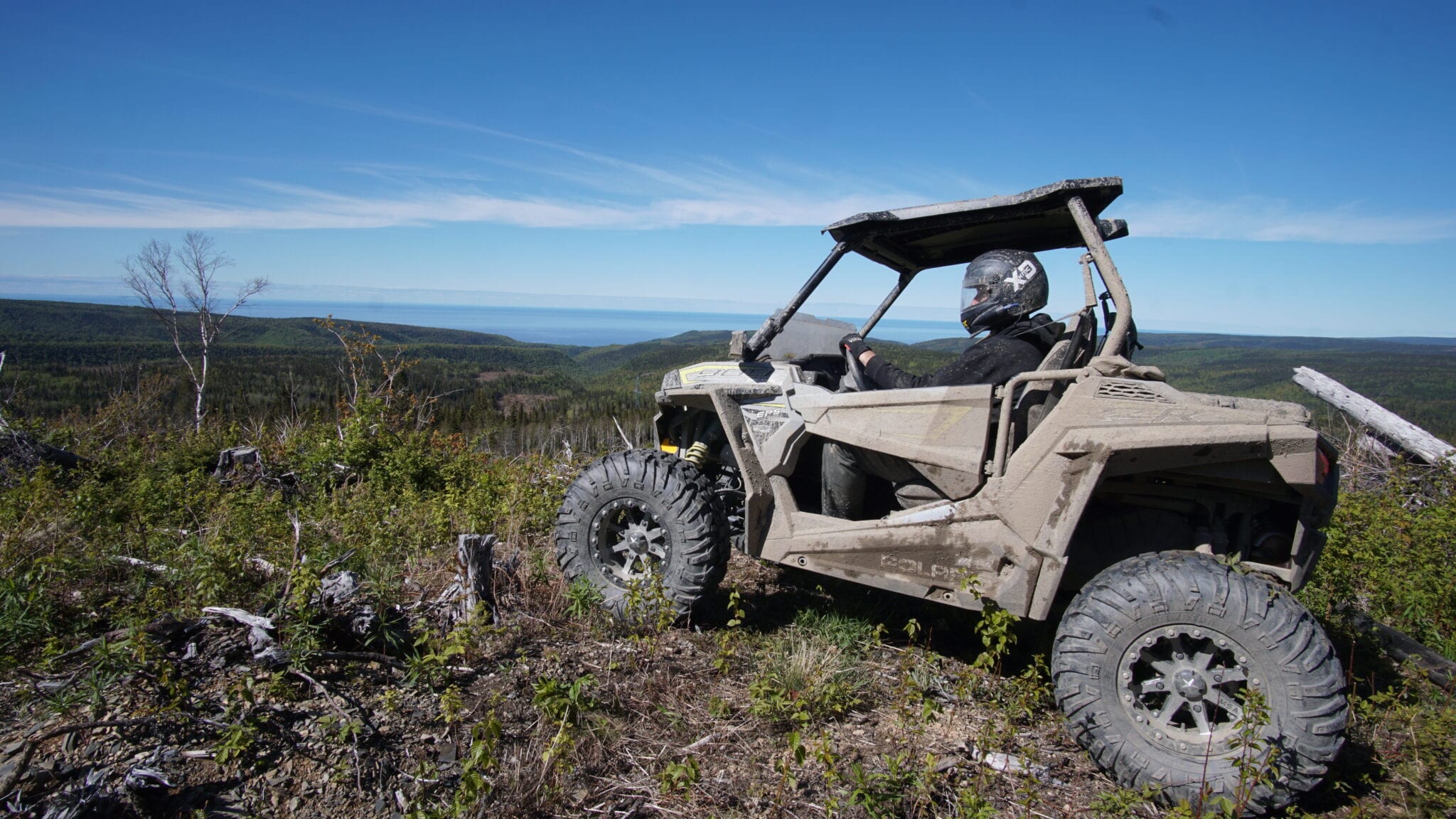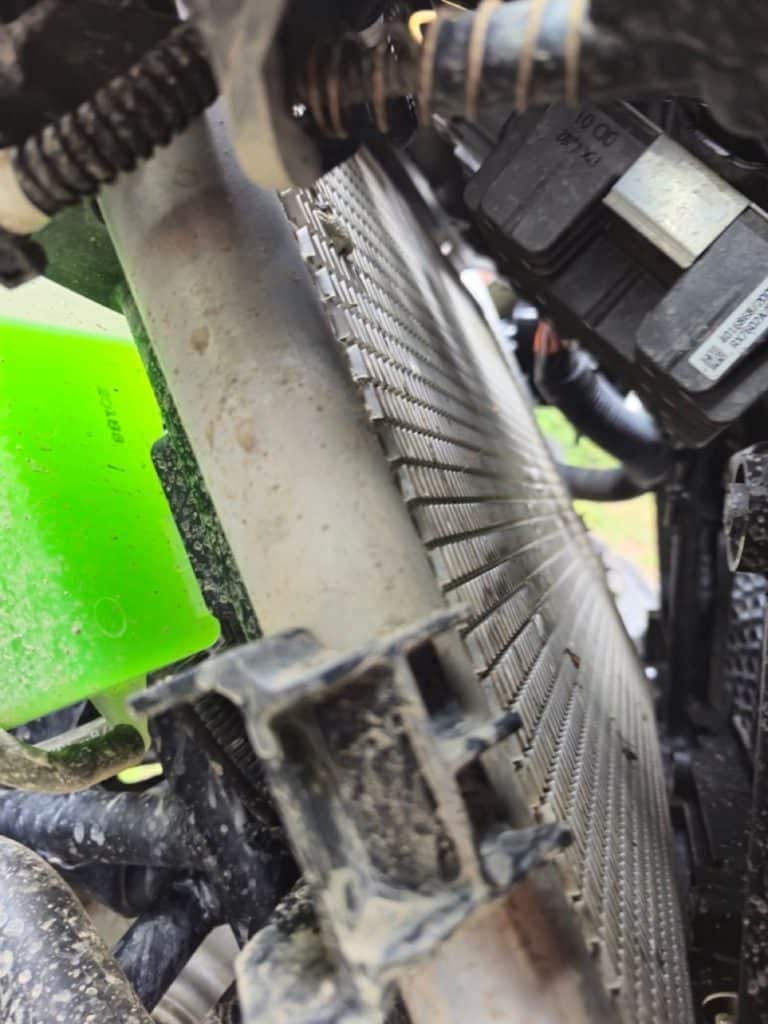When we talk about Destination Polaris TV show, we are talking about an ATV television production that has ratings of 7-million people in North America, the equivalent of the population of the province of Quebec as a whole! The show is in its eighth season and there is no doubt that to be able to maintain such an audience, it has to have the style to present ATVs in a dynamic, credible way that brings the viewersi into the sport. The show puts Polaris vehicles into action in the most captivating sets in North America and beyond. They also cover racing and Project X, an ongoing project that converts ordinary ATVs into monstrous machines for extreme conditions.
Recently, I was able to work with them for two days at the foot of the Chic-Chocs Mountains in Gaspésie, to see how they set up the canvas of a show and how they embroider the scenes around to make an episode.

The Destination Polaris Team.
The crew is surprisingly low staffed: hostess Lindsey Hayes and two incredibly effective cameramen are responsible for the production of the episode during the three-day stay in the region. However, their material is quite impressive. Three friendly representatives from WheelPros and EFX Tires were along for the ride.

Since everyone is asking me, yes, I had the privilege of meeting Lindsey Hayes. She is a very professional person who directs her team to get the vision she has for the show. But above all, she is very approachable and likes to have a good laugh when the work is done. She can also handle herself on any ATV. On this trip, she learned to call a moose, and she did pretty well. Above all, she was kind enough to explain to me how she saw the conceptualization of an episode and she let me watch her team at work.
Simple recipe, but sophisticated cuisine.
Surprisingly, the destinations come to the producers mainly through word of mouth. This makes sense, because who can better appreciate an exceptional site for an ATV adventure than another off-road enthousiast? This is how they ended up at Grande Nature Village at the foot of the Chic-Chocs Mountains, just behind Cap-Chat, to film this episode.

When we say simple recipe, we are not saying simplistic, although spreading in a lot of subjects for an episode that will run 22 minutes runs the risk of getting disjointed. The show sticks to three or four topics that will be covered. Once the site is chosen, a serious search is done to identify attractions that identify the area that will be showcased. This way, when the team arrives on site, they already have a good idea of the basic scenario of how the episode will shake out. For the episode that I was observing, four attractions were planned: a lighthouse for the maritime identity of the Gaspésie, the observation of a moose in its natural environment, a technical ride in the mud to test the EFX Tires in real conditions and a waterfall. And of course, they will highlight the accommodations in the area.

Lindsay explained to me that she sees the four segments as small boxes to be filled, and she assesses during filming what percentage of time they need to cover the subject. Sometimes the subject does not only depend on the team but also nature. For example, getting film of the moose in its natural environment represents a risky bet. Even if you are right next to the Matane reserve where the moose population per square kilometer is one of the best in Quebec, it is always necessary that the king of the forests willingly collaborate to get him on film. This finally materialized in extremis in the last hour of the last day, much to the delight of Lindsay and her team.
While looking for moose, Cole O’Brien, one of the cameramen, was standing across the roof of the Ram truck they were using. Rejean, the owner of the pickup truck, would not appreciate much Cole’s shoes on the central leather armrest, Cole had the to climb on the armrest in stocking feet. When the moose decided to show the tip of his muzzle, everyone came out of the pickup truck to try to approach the beast. Rejean, behind Cole, made moose calls and raised his hands on each side of the head in an effort to attract the attention of the moose. This let Cole slowly approach closer to thirty feet to film it … in stocking feet! This illustrates how the team is dedicated to the mission of producing the best possible show.
Professionalism is also in the optimal use of the production equipment. Sony FS7 4K cameras, GoPros, radio communications, a Phantom 3 drone – all great equipment. But it takes the artistic talent of the technicians who will use them is essential to have the striking images the show is known for. With the team of Destination Polaris, the scenes roll together smoothly. Some radio exchanges, one or two shots and the scene comes together. For example, the opening scene was set around the balustrade of a lighthouse. While Lindsay Hayes speaks to the drone (via a microphone) flying in front of her, the drone begins to retreat while gaining altitude as Lyndsay says, “Welcome to Destination Polaris.” A few hours later, Lyndsay shows me on a small screen the result of this scene that will open what is sure to be another strong episode. The way the scene unfolded, Lindsay invited the audience to share in the greatness of the Gaspésie.

Each scene is set up for optimal filming. The cameras are positioned and double checked. One or two passes with the RZR and we re-set the whole thing to make sure it is perfect. It is very interesting to see them work as they analyze the layout with the area where the eye of the camera will capture the image and not in the entire field of vision of the human eye. During the interview of the team from WheelPros, the guys found themselves sitting on a cooler in the middle of a bonfire, but the camera saw the guys from the shoulders up, the line of the Chic-Chocs mountains in the background and a RZR parked at the back. Everything will be perfect on screen.
Lindsay also has a great talent as an interviewer when she addresses her guests by asking questions about the events of the last few days and when the answers are too concise to her taste, she is quick to come back with a follow-up question that gets the information she is hoping for. Everything is done to highlight the guests and the subjects. Obviously, the final touch will be made in the editing, and I have no idea how and in what order everything will presented in the episode. By viewing other episodes on the Destination Polaris website, the ideas are usually presented with a fast-enough pace to keep you interested, and the scenes fuel the imagination to get you to want to go rolling through these parts of the country. Also, the guest spots are inserted throughout the story with comments that complete the subject at the appropriate time. The team knows what they are doing for sure.

The base camp where the team was staying is the Grande Nature Village located in St-Octave de l’Avenir, behind Cap-Chat, Gaspésie. St-Octave de l’Avenir is a colonization village that appeared on the map during the Great Depression of the 30s. Located at 1443 ft (440m) of altitude and just at the foot of the Chic-Choc Mountains, life was rough and the village was shut down by the government in 1971. The remaining houses were burned. The remains of the village are the school and the church, recently transformed into a congress hall of 350 people of capacity and a summer theater. St-Octave is now a thriving tourist resort that offers accommodation in inns, Canadian or Scandinavian chalets. The four-star table will delight even the most demanding palates. Finally, a host of activities are offered, including motorized sports such as ATV biking and other more surprising activities such as nocturnal wildlife watching. The Grande Nature Village is a must-see tourist attraction for ATV riders passing through the region.






